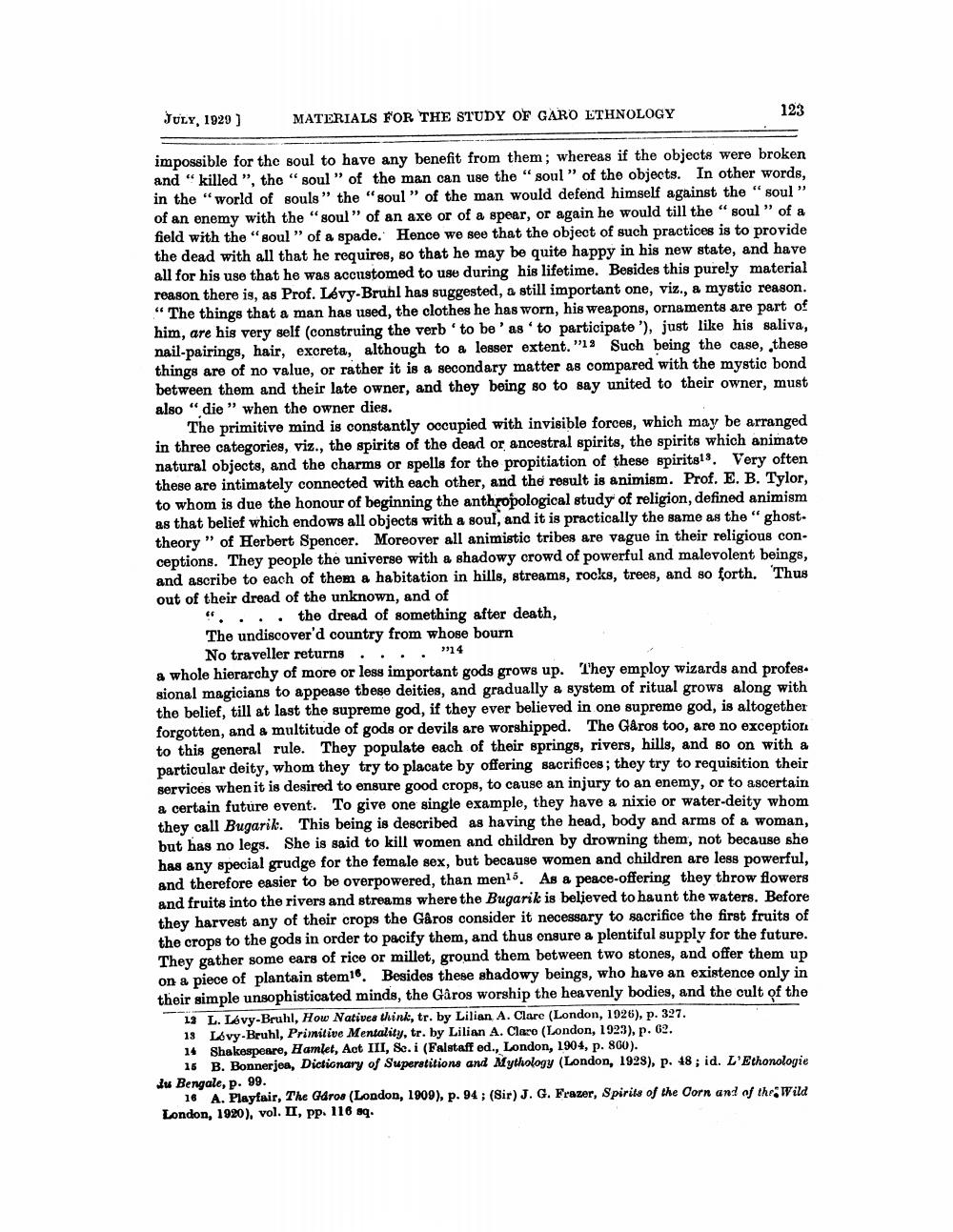________________
JULY, 1929 )
MATERIALS FOR THE STUDY OF GARO ETHNOLOGY
123
impossible for the soul to have any benefit from them; whereas if the objects were broken and killed ", the "soul" of the man can use the "soul" of the objects. In other words, in the "world of souls" the "soul ” of the man would defend himself against the "soul ” of an enemy with the "soul" of an axe or of a spear, or again he would till the “soul ” of a field with the "soul ” of a spade. Hence we see that the object of such practices is to provide the dead with all that he requires, so that he may be quite happy in his new state, and have all for his use that he was accustomed to use during his lifetime. Besides this purely material reason there is, as Prof. Lévy-Bruhl has suggested, a still important one, viz., a mystic reason. “The things that a man has used, the clothes he has worn, his weapons, ornaments are part of him, are his very self (construing the verb 'to be 'as 'to participate '), just like his saliva, nail-pairings, hair, excreta, although to a lesser extent."13 Such being the case, these things are of no value, or rather it is a secondary matter as compared with the mystic bond between them and their late owner, and they being so to say united to their owner, must also "die ” when the owner dies.
The primitive mind is constantly occupied with invisible forces, which may be arranged in three categories, viz., the spirits of the dead or ancestral spirits, the spirits which animate natural objects, and the charms or spells for the propitiation of these spiritsid. Very often these are intimately connected with each other, and the result is animism. Prof. E. B. Tylor, to whom is due the honour of beginning the anthropological study of religion, defined animism as that belief which endows all objects with a soul, and it is practically the same as the "ghost. theory" of Herbert Spencer. Moreover all animistic tribes are vague in their religious conceptions. They people the universe with a shadowy crowd of powerful and malevolent beings, and ascribe to each of them a habitation in hills, streams, rocks, trees, and so forth. Thus out of their dread of the unknown, and of
".... the dread of something after death, The undiscover'd country from whose bourn
No traveller returns .... "14 a whole hierarchy of more or less important gods grows up. They employ wizards and profes. sional magicians to appease these deities, and gradually a system of ritual grows along with the belief, till at last the supreme god, if they ever believed in one supreme god, is altogether forgotten, and a multitude of gods or devils are worshipped. The Garos too, are no exception to this general rule. They populate each of their springs, rivers, hills, and so on with a particular deity, whom they try to placate by offering sacrifices; they try to requisition their services when it is desired to ensure good crops, to cause an injury to an enemy, or to ascertain a certain future event. To give one single example, they have a nixie or water-deity whom they call Bugarik. This being is described as having the head, body and arms of a woman, but has no legs. She is said to kill women and children by drowning them, not because she has any special grudge for the female sex, but because women and children are less powerful, and therefore easier to be overpowered, than men15. As a peace-offering they throw flowers and fruits into the rivers and streams where the Bugarik is believed to haunt the waters. Before they harvest any of their crops the Gâros consider it necessary to sacrifice the first fruits of the crops to the gods in order to pacify them, and thus ensure a plentiful supply for the future. They gather some ears of rice or millet, ground them between two stones, and offer them up on a piece of plantain stem16. Besides these shadowy beings, who have an existence only in their simple unsophisticated minds, the Gâros worship the heavenly bodies, and the cult of the
13 L. Lévy-Bruhl, How Natives think, tr. by Lilian A. Clare (London, 1926), p. 327. 18 Lévy-Bruhl, Primitive Mentality, tr. by Lilian A. Claro (London, 1923), p. 62. 14 Shakespeare, Hamlet, Act III, Se. i (Falstaff ed., London, 1904, p. 800).
16 B. Bonnerjea, Dictionary of Superstitions and Mythology (London, 1928), p. 48 ; id. L'Ethonologie Ju Bengale, p. 99.
16 A. Playfair, The Garos (London, 1909), p. 94 ; (Sir) J. G. Frazer, Spirits of the Corn and of the Wild London, 1920), vol. II, pp. 116 sq.




